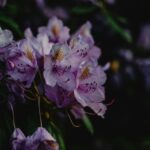Rhododendron
$150.00
The Rhododendron (Rhododendron spp.) is a stunning and versatile shrub that adds elegance, color, and year-round interest to any garden or landscape. Its spectacular blooms, evergreen foliage, and varied sizes make it a cherished choice for enhancing outdoor spaces.
Rhododendrons are elegant and majestic shrubs known for their stunning clusters of flowers and lush, evergreen foliage. With their vibrant blooms and year-round interest, Rhododendrons are ideal for adding a touch of sophistication and color to gardens, landscapes, and shaded areas.
Key Features:
- Spectacular Blooms: Rhododendrons produce large, showy flower clusters in a variety of colors, including pink, red, white, purple, and orange. The blooms are often fragrant and appear in spring, providing a spectacular display of color.
- Evergreen Foliage: The plant features glossy, dark green leaves that remain attractive throughout the year. The evergreen nature of Rhododendrons ensures that your garden maintains its greenery even in winter.
- Varied Sizes: Rhododendrons come in various sizes and growth habits, from compact dwarf varieties to large, towering shrubs. This variety allows you to choose the perfect fit for your garden or landscape design.
Plant Care:
- Watering: Rhododendrons prefer consistent moisture but should not be waterlogged. Water regularly to keep the soil evenly moist, especially during dry periods. Use mulch to help retain soil moisture and regulate temperature.
- Light: Thrives in partial to full shade. Rhododendrons perform best in locations with morning sun and afternoon shade, although they can tolerate some full sun in cooler climates. They are well-suited to shaded woodland gardens or under the canopy of larger trees.
- Soil: Prefers acidic, well-draining soil rich in organic matter. A slightly acidic pH of 4.5 to 6.0 is ideal. Amend soil with peat moss or compost to improve drainage and nutrient content.
- Temperature: Hardy in USDA zones 4-9, depending on the variety. Rhododendrons can tolerate cold temperatures but may need protection from harsh winter winds. In colder regions, mulch around the base to insulate the roots.
- Humidity: Prefers average to high humidity levels. Rhododendrons thrive in environments with good air circulation and may benefit from misting or nearby water features in drier climates.
- Maintenance: Prune after flowering to shape the plant and remove any dead or damaged branches. Deadhead spent blooms to encourage new growth and improve the plant’s appearance. Fertilize in early spring with an acid-loving plant fertilizer to support healthy growth and blooming.
Tip: Rhododendrons are ideal for creating lush, colorful garden borders, woodland gardens, or foundation plantings. They also make excellent specimens in containers or large pots. Choose varieties suited to your climate and soil conditions to ensure successful growth.
Related products
The Geranium (Pelargonium spp.) is a vibrant and adaptable plant that adds color and charm to any space. Its long-blooming period, variety of colors, and ease of care make it a favorite choice for enhancing gardens, balconies, and indoor areas alike.
The Fern (Polypodiopsida) is a graceful and adaptable plant that enhances any space with its delicate, feathery foliage and natural beauty. Its versatility, low maintenance, and elegant appearance make it a wonderful choice for adding a touch of sophistication and tranquility to both indoor and outdoor settings.
Sage is a versatile and aromatic herb known for its distinctive flavor, elegant foliage, and numerous culinary and medicinal uses.
The Peony (Paeonia spp.) is a stunning and elegant plant that adds a touch of luxury and charm to any garden or floral display. Its large, fragrant blooms, lush foliage, and long-lasting beauty make it a cherished choice for enhancing outdoor spaces and indoor arrangements.
The Azalea (Rhododendron spp.) is a beautiful and vibrant addition to any garden or indoor space. Its colorful blooms, seasonal interest, and relatively manageable care requirements make it a favorite among plant enthusiasts looking to add a splash of color to their surroundings.









Reviews
There are no reviews yet.